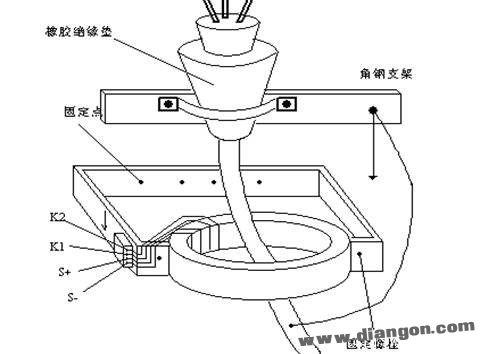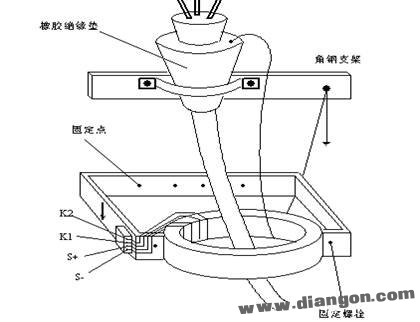The zero-sequence current protection application can be equipped with a current transformer (CT) on each of the three-phase lines, or let the three-phase wires pass through a zero-sequence CT together, or a zero-sequence CT can be installed on the neutral line N. These CTs detect the current vector sum of the three phases, that is, the zero sequence current Io, IA+IB+IC=IO, when the three-phase load connected to the line is completely balanced (no ground fault, and the leakage current of the line and electrical equipment is not considered). ), IO=0; when the three-phase load connected to the line is unbalanced, IO=IN, the zero-sequence current at this time is the unbalanced current IN; when a phase fault occurs in a phase, a single-phase grounding is inevitable The fault current Id, the zero sequence current detected at this time, IO=IN+Id, is the vector sum of the three-phase unbalanced current and the single-phase ground current.
Zero-sequence current protection is generally suitable for use in TN grounding systems.
The 10 kV neutral point low-resistance grounding system is widely used in power grids across the country. Substation, switching station 10 kV line zero-sequence protection device uses more and more zero-sequence current transformers. It has been used in installation and use. Even the zero sequence protection device is rejected when the ground fault occurs, and the protection is overstepped.
1, the installation problems
(1) The zero-sequence current transformer shall be installed on the bottom of the switch cabinet and shall be secured by a reliable bracket. However, some manufacturers or construction units install the zero-sequence current transformer on the bracket below the bottom plate of the switch cabinet, and even more, the zero-sequence current transformer is bundled on the cable, which is contrary to the principle of full closure of the switchgear, which is not safe. It is also not dustproof, and it is not against small animals, leaving many hidden dangers.
(2) After the cable termination head passes through the external zero-sequence current transformer, the relative position of the cable metal shield ground wire and the external zero-sequence current transformer is incorrect. According to the relevant regulations: the metal sheath at the terminal of the three-core power cable must be well grounded; the copper shield of each phase of the plastic cable and the soldering ground of the steel enamel should be soldered (oil-impregnated paper insulated cable lead package and armored welding ground wire), cable When passing through the zero-sequence current transformer, the cable sheath and grounding wire should be insulated from the ground. When the cable grounding point (the soldering ground of the cable grounding wire and the cable metal shield) is below the transformer, the grounding wire should be directly grounded (see Figure 1). ; 
figure 1
When the grounding point is above the transformer, the grounding wire should pass through the transformer grounding (see Figure 2). The grounding wire must be connected to the special grounding copper bar in the switchgear. The grounding wire must be copper stranded wire or tinned copper braided wire. The cross section of the grounding wire must comply with the regulations. During the inspection, it was found that some cable grounding wires were not worn when wearing zero-sequence current transformers, and some of them should not be worn by the zero-sequence current transformers, which caused the accident grounding zero-sequence protection to fail to operate correctly. 
figure 2
(3) Since the cable terminal is made larger, the current transformer magnetic circuit is not closed. The commonly used 10 kV power cable is a three-core cross-linked polyethylene cable with a cross section of 240 mm2 and 300 mm2. The outer diameter of the cable is thicker, and the hot-melt sealant attached to the three-core glove is thicker and has zero-sequence current. The transformer can not be put on, the zero-sequence current transformer interface is disconnected during construction, the cable cover comes over, but the interface forgets to recover; some recover, but the interface recovery is not strict; more terminal three-core separation is better than zero The inner diameter of the current transformer is thick and just stuck in the middle of the zero-sequence current transformer, so that the zero-sequence current transformer interface cannot be restored and closed, causing the zero-sequence current transformer magnetic circuit to be closed and unable to work normally.
(4) The secondary splicing of the zero-sequence current transformer is opened during the cable construction, and is not restored in time after the completion of the work, causing the secondary winding of the current transformer to open.
(5) The grounding end of the cable metal sheath grounding wire is not soldered to the terminal block, nor is it connected to the grounding copper bar provided in the switchgear cabinet, but is simply attached to the switch cabinet body bolt.
2, the correct construction method
The 10 kV line zero-sequence protection device adopts an external zero-sequence current transformer, which should be noted in the design and construction:
(1) It should be ensured that the inner diameter of the zero-sequence current transformer is greater than the outer diameter of the cable terminal;
(2) Try not to disassemble the zero-sequence current transformer during construction. If it must be dismantled, it must be restored to its original state after the work is completed;
(3) The grounding wire shall be copper wire or tinned copper braided wire. The cross section of the grounding wire shall not be less than 25 mm2. The grounding end shall be welded with the terminal and correctly handle the relative position of the grounding wire and the zero-sequence current transformer. The ground wire must be installed on the grounded copper bar;
(4) Before the power is turned on, the zero sequence protection system should be adjusted to ensure normal protection.
What is the characteristic of zero-sequence current protection? The biggest characteristic of zero-sequence current protection is that it only reacts to single-phase ground faults. Since other non-grounded short-circuit faults in the system do not produce zero-sequence current, the zero-sequence current protection is not disturbed by any faults.
What is the zero sequence current protection device zero sequence current protection device:
In a grid that is directly grounded at a neutral point (also known as a large ground current system), a large zero-sequence current will occur when a single-phase ground fault occurs. A protection device that uses a zero-sequence current to form a short-circuit to the ground is called a zero-sequence current protection device. Three-stage is often used.
Zero-sequence I segment: instantaneous zero-sequence current quick-break, protect the total length of the line from 70% to 80%
Zero-sequence II: With time-limited zero-sequence current quick-break, protect the full length of the line and a part of the next line.
Zero-sequence III: Zero-sequence over-current protection to protect the backup of the full length of the line and the next line.
Steel Cord For Conveyor Belts
Steel cord conveyor belts are highly wear-resistant and used principally for long-haul conveying, heavy loads and physically demanding applications. They are especially suitable for high-mass or high-volume flows and for abrasive materials.
Steel cord Conveyor Belt Construction
The steel cord belt provides superior impact resistance, with the number and size being selected to meet the desired operating tension and application needs. The insulation gum is specifically designed to encapsulate each steel cord filament to reduce internal friction while providing enhanced adhesion to the cover rubbers. Top and bottom covers provide maximum protection to the steel cord. The cover compounds are specifically designed to meet the demands of the application and are available in a wide variety of rubber types and gauges.
Steel Cord,Steel Cord Wire,Steel Wire Cord,Conveyor Belt Steel Cord
ROYAL RANGE INTERNATIONAL TRADING CO., LTD , https://www.royalrangelgs.com
